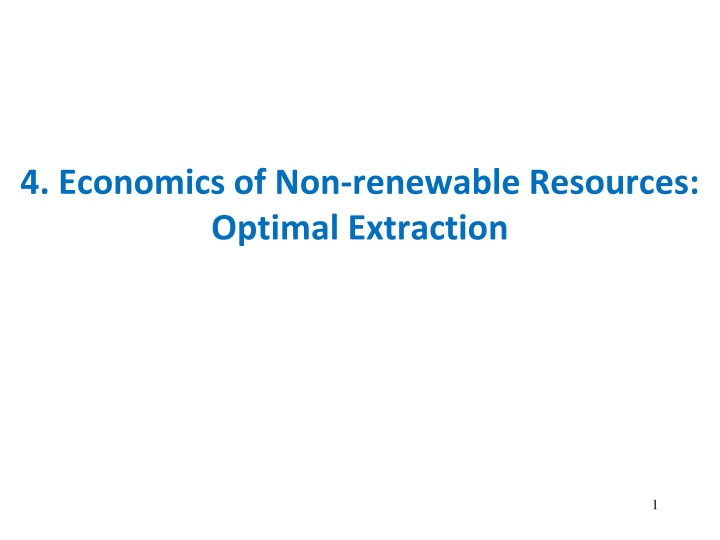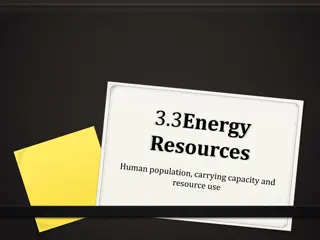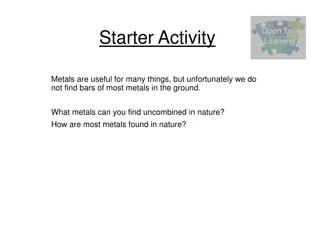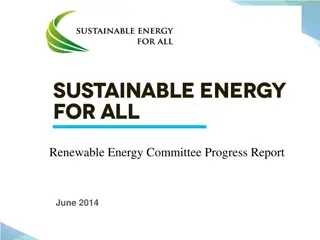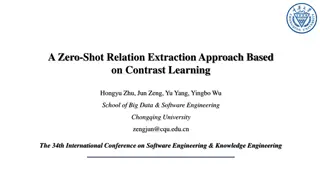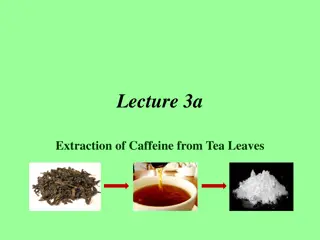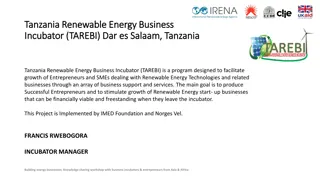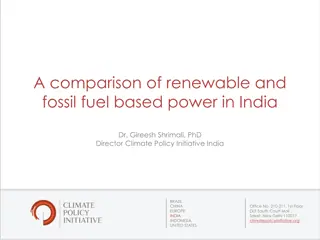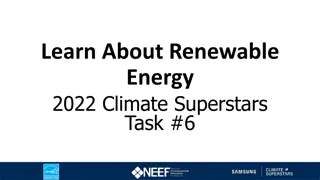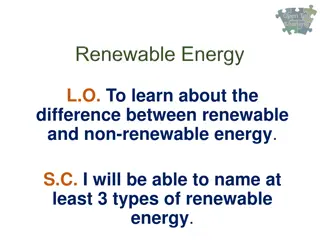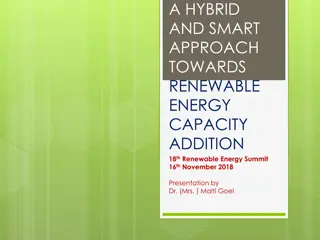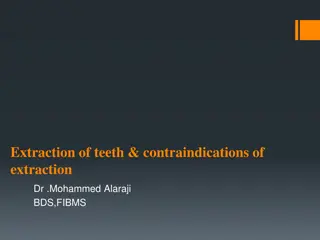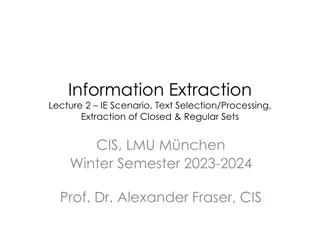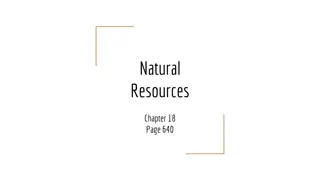Optimal Extraction of Non-renewable Resources: Categories, Inquiries, and Efficiencies
The dynamics of non-renewable resources through categories such as renewable vs. non-renewable, probative inquiries on oil and diamonds, and the concepts of static and dynamic efficiency. Understand how market dynamics and modeling play a crucial role in resource allocation for maximizing net social benefits over time.
Download Presentation

Please find below an Image/Link to download the presentation.
The content on the website is provided AS IS for your information and personal use only. It may not be sold, licensed, or shared on other websites without obtaining consent from the author.If you encounter any issues during the download, it is possible that the publisher has removed the file from their server.
You are allowed to download the files provided on this website for personal or commercial use, subject to the condition that they are used lawfully. All files are the property of their respective owners.
The content on the website is provided AS IS for your information and personal use only. It may not be sold, licensed, or shared on other websites without obtaining consent from the author.
E N D
Presentation Transcript
4. Economics of Non-renewable Resources: Optimal Extraction 1
Categories of Natural Resources Nonrenewable vs. Renewable Renewable: high rate of generation or regeneration. Non-renewable: finite quantity, rate of generation insignificant compared with rate of use. With non-renewables, we are concerned with determining efficientinter-temporal consumption. 2
Probative Inquiry Suppose you found oil at your field, how would you plan to sell it? If the country found diamond, how the Ministry of Mineral Exploration should be advised to sell it out? Practical vs Scientific ??? 3
Static efficiency vs Dynamic efficiency 1) Static efficiency Static efficiency exists when resource decision in different time periods are independent. Maximizing net social benefit (producer surplus and consumer surplus) in each time period. Efficiency in consumption Efficiency in product mix Efficiency in resource mix 4
2. Dynamic efficiency Resource use decisions based on market dynamics. Market dynamics: market variation due to interactions between resource extraction and resource stock overtime. 5
Modelling Market Dynamics Demand function: ??= ?(???,??? ?,??) Pt = the price of non-resource in period t Qdt = qtty demanded of non-renewable resource in period t Qdt-1 = qtty demanded of non-renewable r/ce in previous period t-1 Rt = demand shifters in period t (preferences, income, quantity demanded of substitutes, .) Supply function: ??= ?(???,??,??) QSt = quantity supplied of substitute resource St = non-renewable resource stock in period t Gt = supply shifters in period t (technology improvement, substitutes, preferences, ). 6
Dynamic Efficiency When a policy or program produces streams of benefits and costs over time, it is dynamic, rather than static. In a dynamic setting, the economically efficient allocation maximizes the present value of net benefits. At this allocation, PV(marginal net benefits)are equal across time periods. If this weren t true, it would be possible to increase the present value of net benefits by re-allocating consumption across time periods. 7
Parameters of Our Two-period Problem: Extraction of 20 Barrels of Oil. = Demand: 8 0.4 MB q = Supply: $2/ MC unit = Stock of resource 20 units = Discount rate: 0.10 r PVNB present value of net benefits 8
Problem with Static Efficiency and Non-renewables Demand for oil: MB = 8- 0.4q $ PERIOD #1 8 MB(Q) MC 2 0 15 barrels extracted (Q) 9
Problem with Static Efficiency and Non-renewables Demand for oil: MB = 8- 0.4q $ $ PERIOD #1 PERIOD #2 8 8 MB(Q) MB(Q) MC 2 MC 2 0 0 15 barrels extracted (Q) 15 barrels extracted (Q) 15+15=30 > 20 units available 10
First Candidate for Two-period Consumption Allocation Candidate 1: Extract 15 in period 1, and leave whatever is left over (5) for consumption in period 2. $ $ PERIOD #1 PERIOD #2 8 8 MB(Q) MB(Q) NB2 NB1 MC 2 MC 2 0 0 15 barrels extracted (Q) 5 barrels extracted (Q) NMB(shaded) = 45 NMB(shaded) = 25 PVNB =45 + 25/(1+.10) = 45 + 22.72 = 67.73 11
Second Candidate for Two-period Consumption Allocation Candidate 2: Extract 5 in period 1, and leave 15 for consumption in period 2. $ PERIOD #2 PERIOD #1 8 8 MB(Q) MB(Q) NB1 NB2 MC MC 2 2 0 0 5 barrels extracted (Q) 15 barrels extracted (Q) NMB = 25 NMB = 45 PVNB =25 + 45/(1+.10) = 25 + 40.9 = 65.9 12
Algebraic Solution to Dynamically Efficient Allocation in Two Periods In a dynamic setting, the economically efficient allocation maximizes the present value of net benefits. At this allocation, PV(marginal net benefits)are equal across time periods. = ( ) ( ) PV MNB PV MNB 1 2 = ( ) ( ) PV MB MC PV MB MC 1 2 8 0.4 (1.10) q = 2 q = 8 0.4 2 q 2 1 1 + = 20 20 q q so q 1 2 2 1 : Substituting 6 0.4 (20 (1.10) ) q = 6 0.4 1 q 1 1 = = = * 1 * 2 * 1 10.239, 20 9.761 q q q = = = 8 8 (0.4 10.239) (0.4 9.761) $3.90 $4.10 p p 1 = 2 13
Non-renewable Resource Extraction: The Two-period Model Marginal Net Benefit in Period #2 ($) discounted at 10% r Marginal Net Benefit in Period #1 ($) PV of MB- MC in Period #1 6 PV of MB- MC in Period #2 5.45 5 4 4 3 3 2 2 1 1 Q in Period #1 0 5 10 15 20 20 15 10 5 0 Q in Period #2 14
Dynamically Efficient Allocation in the Two-period Model Marginal Net Benefit in Period #2 ($) discounted at 10% r Marginal Net Benefit in Period #1 ($) PV of MB- MC in Period #1 6 PV of MB- MC in Period #2 5.45 5 4 4 3 3 2 2 1 1 Q in Period #1 0 5 10 15 20 20 15 10 5 0 Q in Period #2 q1=10.239 q2=9.761 From demand function, p1=3.90 [MB = 8- 0.4q] 15 p2=4.10
Dynamic Efficiency with Constant Marginal Extraction Costs MUC is marginal user cost MEC is marginal extraction cost P ($) 8 Period #1 p1 = 3.90 MUC1 = 1.90 MEC 2 demand 0 Q 5 10 15 20 P ($) q1 = 10.239 8 Period #2 p2 = 4.10 MUC2 = 2.10 MEC 2 demand Q 0 5 q2 = 9.761 10 15 20 16
Scarcity and Marginal User Cost Marginal user cost (or scarcity rent) of current consumption is the opportunity cost of forgone future consumption. For non-renewables, MUC=P-MEC This extra cost is a negative externality from the extraction of non-renewable resources. Must be internalized for market equilibrium allocation to be efficient. 17
The Hotelling Rule Methods for solving for the dynamically efficient allocation of the fixed stock of resource over time. The dynamically efficient allocation occurs when the PV of marginal profit (also known as marginal scarcity rent or marginal Hotelling rent) for the last unit consumed is equal across the various time periods. Two time period example: (?? ??)? (?+?)? =(?? ??)? (?+?)? 18
At the dynamically efficient extraction allocation of a non-renewable resource with constant marginal extraction cost, the marginal user cost rises over time at the rate of interest (the opportunity cost of capital). MUC MUC P P MEC MEC = = r or r MUC t = r , : In the discrete two MUC MUC period case MUC MUC MUC = = 2 1 r 1 Therefore, price also rises at the rate of interest [since MEC is constant refer fig. on pg. 12] No-arbitrage condition: if it were possible to make more ($) by shifting consumption around, the private owner would do that. 19
Assumptions of Hotelling Model Constant marginal extraction costs: only MUC changes over time. Private, competitive owners of non-renewable resources: property rights are well defined. Future price path is known (or equilibrium in expectations ) 20
Generalizing from 2 Periods to N Periods Generalizes to the n-period case. Hotelling rule still holds for constant MEC. Exhaustion of the resource will occur at the point where MEC+MUC= reservation price or choke price , if such a price exists. What does the choke price or reservation price represent? 21
Transition to a Backstop (substitute) Technology $ Choke Price MEC of backstop p 0p 0 Time Time at which non-renewable resource is exhausted and a backstop is discovered , thus shifting to the backstop use so that price of the non-ren. res. tapers off 22
What sets P*? A Transition to Other Non-Renewables We can consider either: Same resource, but ores of different quality (coal with high or low energy content); or Different resources entirely (coal vs. oil) Multiple transitions, based on incremental exhaustion of better resources (less costly). Can think of backstop technology at end of process, as well. 23
Multiple non-renewable transitions, with backstop technology $ MEC of backstop p 2 p 1p 0p 0 Time Non-renewable resource 2 is exhausted Non-renewable resource 3 is exhausted Time at which non-renewable resource 1 is exhausted 24
Extraction Today Affects Future Costs: Increasing Marginal Extraction Costs Cost of extracting one unit of the resource increases as the stock gets smaller. Common terminology: Stock effect Now there is an extra cost to extracting today the effect on future extraction costs. Disincentive to extract extraction rate slows. Typically, with stock effects, exhaustion is not dynamically efficient. 25
Stock of a Non-renewable Resource How would we define the stock of a non- renewable resource? Ore/reserves that are feasible to extract at current prices and technologies. Is this an exogenous entity? How would technological change affect stock? How does this create incentives for firms? What about the choke price? 26
Will the Market Achieve Dynamic Efficiency? Yes, under certain assumptions, many of which are met in the markets for non-renewables. Private owners of resources will consider scarcity, not simply their extraction costs, or they risk missing out on a capital gain. Can we tell from market data whether the markets for non- renewables are dynamically efficient? 27
Conditions Under Which Dynamically Efficient Extraction Will Not Occur in Private Markets Non-competitive market structure (monopolies, cartels) Asymmetric information Incomplete markets Externalities in production or consumption Public goods Tragedy of the commons/open access resources Divergence between private and social discount rates 28
Non-competitive Markets: Monopoly For monopolist, Hotelling Rule is slightly different: ( MR ) MR MEC MEC = r ( ) For most reasonable demand functions, monopolist extracts more slowly, exhausts resource later than competitive private owner. Monopolist increases total profits from resource by restricting output in early time periods monopoly rents. This is because restricting output raises the price in the early time periods and more profits can be reaped early rather than later, therefore slower extraction total PV increases by restricting output in the early time periods. 29
For a monopolist, MC (S) is rising and not constant increased supply only at higher price and thus control over supply of resource At q1 NB = P C = p1c1 P p1 p2 c2 c1 MB (D) MC (S) which is greater than, At q2 NB = P C = p2c2 q1 q2 Q 30
= ( ) ( ) PV MNB PV MNB 1 2 = ( ) ( ) PV MB MC PV MB MC 1 2 8 0.4 2 q 8 0.4 = 2 q 2 1 1 (1.10) = + = 20 20 q q so q q 1 2 2 1 : Substituting 6 0.4 (20 (1.10) ) q 6 0.4 = q 1 1 1 = = = * 1 * 2 * 1 10.239, 20 9.761 q q q = = 8 (0.4 10.239) 8 (0.4 9.761) = $3.90 $4.10 p p 1 = 2 For a given price, q1 < q2 to equate PVMB1 = PVMB2 31
Exploration and Technological Progress Technological progress can shift the MEC function downward over time. Exploration and discovery can also shift the MEC function downward over time. Both technological R&D and exploration exhibit diminishingreturns over time. While costs may fall initially, when diminishing returns set in, costs will begin to rise. 32
solve Demand = MB = 25 0.8q Supply = MC = 5/unit Stock = 40 units Discount rate, r = 10% = 0.10 MUC = marginal user cost = P MC t = time period -------------------------------------------------------------------------------------------------------------------------------- 1. Find q1 & q2 2. Find p1 & p2 3. Find MUC in t1 & t2 33
Dynamically Efficient Allocation in the Two-period Model 25 [NMB1] 20 15 [NMB2/1.1] 25 20 18.18 15 10 10 q1 0 36 32 28 24 19.76 5 5 8 12 16 20.24 24 25 28 32 4 16 15 12 8 0 q2 34
Dynamic Efficiency with Constant Marginal Extraction Costs MUC is marginal user cost MEC is marginal extraction cost P ($) 25 Period #1 p1 = 8.81 MUC1 = 3.81 MEC 5 demand 0 Q 10 20 30 40 P ($) q1 = 20.24 25 Period #2 p2 = 9.19 MUC2 = 4.19 MEC 5 demand Q 0 10 q2 = 19.76 20 30 40 35
Conclusions/observations Because q1 > q2, p1 < p2 Given MEC, higher p2 implies higher MUC in future time periods For a given p, q1 < q2 to equate PVMB1 = PVMB2 => p > MC = monopoly rents As extraction continues, stock depletes so that MUC continuously increases for all future time periods 36
Implications for Environmental Policy Many unsustainable allocations are the result of inefficient behavior. Correcting the inefficiency can either restore sustainability or move the economy a long way in that direction. The combination of efficiency with sustainability turns out to be very helpful in guiding environmental policymaking. Do our economic and political institutions produce outcomes that are both efficient and sustainable? 37
